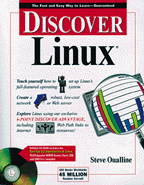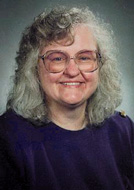

 |
 |

Not just another book for the total novice, Discover Linux is written for the Linux newcomer who is an experienced UNIX user. It covers a lot of territory from the requisite installing Linux to setting up PPP to using Linux in the office. Many of the applications discussed are introduced with one or two short paragraphs, and a web address for obtaining more information. The word processor LyX and ispell are two that are handled this way. Other applications, such as Applixware and xv, are given more space and have some options explained. Plenty of screen shots, all in black and white, go along with the text.
On the subject of screen shots, about midway through the book is a chapter (Part II, Chapter 8) on games in which every screen saver available with X is shown in black and white. To me, this seemed a bit of a waste of space. Also, all of the games are given just an introductory sentence or two and a screen shot. There is nothing in-depth here and that's fine. It is certainly not the purpose of this book to provide a tutorial on every application; rather, to give an overview that allows the user to pick from the many options which appeal to her.
Sprinkled throughout the book are tips, cautions and short anecdotes about various subjects; some are funny, some are not. All provide some information and a nice break.
The first part of the book is called ``Up and Running with Linux''. It covers installation, getting started, getting help, configuration and backing up. The information provided is complete for those who already have some idea of what they are doing. The instructions for installing Linux are given in an easy-to-follow list format that should be understandable even to rank newbies. Just follow the steps--one, two, three--and you have a working Linux system. The book comes with the requisite CD-ROM which contains Red Hat Linux 4.2, a step behind, as usual with books, but certainly a very stable version for a newcomer. At any rate, the instructions for installation are therefore geared towards Red Hat users, as is true for all instructions throughout the book. Since Red Hat is the only distribution on the CD-ROM, this makes sense.
The second part of the book, ``Fun and Games'', covers connecting to the Internet as well as the games mentioned previously. Again, Mr. Oualline provides step-by-step instructions for connecting with PPP, including discussions of chat scripts, minicom and pppd. He also tells you how to download and set up Netscape Navigator.
Part III is called ``Linux in the Office'' and covers mail programs, the X Window File Manager, Linux as a server and DOS. Mail programs, office applications and databases are treated similarly to the games. A short introduction is given with an example or screen shot and then a pointer is given to places on the Web for more information. The author presents Applixware as a bonus, stating ``Move over Microsoft.'' He ignores the fact that StarOffice now comes with Caldera, stating only that the German documentation makes it hard for English-only users. For Linux as a server, he does a good job of presenting SMB, NFS and NIS, telling you how to set up and use them. AMD, RAID, IPX and Appletalk are mentioned briefly.
Part IV, ``Multimedia and Programming Tools'', follows the same pattern. Some subjects are given more attention than others, but you find out something about everything. An interesting chapter in this section is Chapter 14, ``Understanding the Initialization Process'', which explains the boot process, including Run Levels and rc scripts.
Part V, ``Advanced Configuration'', gives some details on configuring XFree86 and customizing your window manager. It also tells you what options are available if you get into trouble and how to report bugs.
Besides the normal Appendices, there is a section (all on blue paper, so you can find it easily) called ``Discovery Center'' which provides a quick reference for accomplishing tasks and points to the page in the book where these tasks are discussed more fully. I felt this section was a good addition, providing a quick way for the user to find the particular task she is interested in at the moment.
All in all, Discover Linux is a good reference for those with UNIX experience who are looking into this radical operating system called Linux.

Marjorie Richardson is Editor of Linux Journal and the e-zine Linux Gazette. She had been a programmer in the oil industry for 20 years before coming to SSC. She likes to quilt, read science fiction, watch action movies and musicals, go to the opera and motorcycle with her husband, Riley. She can be reached via e-mail at ljeditor@ssc.com.